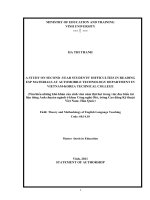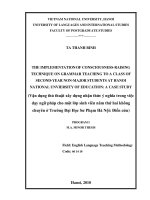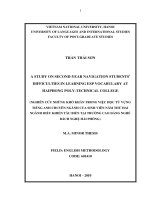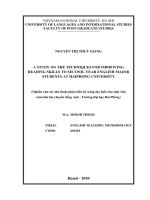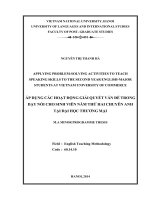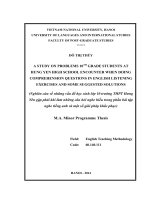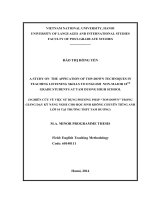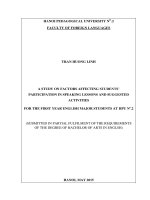A study on second year english major students’ dificulties in listening comprehension skills at HPU
Bạn đang xem bản rút gọn của tài liệu. Xem và tải ngay bản đầy đủ của tài liệu tại đây (941.66 KB, 57 trang )
BỘ GIÁO DỤC VÀ ĐÀO TẠO
TRƯỜNG ĐẠI HỌC DÂN LẬP HẢI PHÒNG
-------------------------------
ISO 9001:2015
KHÓA LUẬN TỐT NGHIỆP
NGÀNH : NGÔN NGỮ ANH
Sinh viên
:Bùi Thị Thuỳ Trang
Giảng viên hướng dẫn: ThS. Nguyễn Thị Quỳnh Hoa
HẢI PHÒNG - 2019
BỘ GIÁO DỤC VÀ ĐÀO TẠO
TRƯỜNG ĐẠI HỌC DÂN LẬP HẢI PHÒNG
-----------------------------------
A STUDY ON SECOND YEAR ENGLISH MAJOR
STUDENTS’ DIFICULTIES IN LISTENING
COMPREHENSION SKILLS AT HPU
KHÓA LUẬN TỐT NGHIỆP ĐẠI HỌC HỆ CHÍNH QUY
NGÀNH: NGÔN NGỮ ANH
Sinh viên
: Bùi Thị Thuỳ Trang
Giảng viên hướng dẫn : ThS. Nguyễn Thị Quỳnh Hoa
HẢI PHÒNG - 2019
BỘ GIÁO DỤC VÀ ĐÀO TẠO
TRƯỜNG ĐẠI HỌC DÂN LẬP HẢI PHÒNG
--------------------------------------
NHIỆM VỤ ĐỀ TÀI TỐT NGHIỆP
Sinh viên: Bùi Thị Thuỳ Trang
Lớp: NA1802
Mã SV: 1412751090
Ngành: Ngôn ngữ Anh
Tên đề tài: A study on Second year English major students’ dificulties in
listening comprehension skills at HPU.
NHIỆM VỤ ĐỀ TÀI
1. Nội dung và các yêu cầu cần giải quyết trong nhiệm vụ đề tài tốt nghiệp
( về lý luận, thực tiễn, các số liệu cần tính toán và các bản vẽ).
……………………………………………………………………………..
……………………………………………………………………………..
……………………………………………………………………………..
……………………………………………………………………………..
……………………………………………………………………………..
……………………………………………………………………………..
2. Các số liệu cần thiết để thiết kế, tính toán.
……………………………………………………………………………..
……………………………………………………………………………..
……………………………………………………………………………..
……………………………………………………………………………..
……………………………………………………………………………..
……………………………………………………………………………..
……………………………………………………………………………..
3. Địa điểm thực tập tốt nghiệp.
……………………………………………………………………………..
……………………………………………………………………………..
……………………………………………………………………………..
CÁN BỘ HƯỚNG DẪN ĐỀ TÀI TỐT NGHIỆP
Người hướng dẫn thứ nhất:
Họ và tên: Nguyễn Thị Quỳnh Hoa
Học hàm, học vị: Thạc sĩ
Cơ quan công tác: Đại học Dân lập Hải Phòng
Nội dung hướng dẫn: A study on Second year English major students’
dificulties in listening comprehension skills at HPU.
Người hướng dẫn thứ hai:
Họ và tên:.............................................................................................
Học hàm, học vị:...................................................................................
Cơ quan công tác:.................................................................................
Nội dung hướng dẫn:......................................................................... ...
Đề tài tốt nghiệp được giao ngày
tháng
năm
Yêu cầu phải hoàn thành xong trước ngày
tháng
Đã nhận nhiệm vụ ĐTTN
Đã giao nhiệm vụ ĐTTN
Sinh viên
năm
Người hướng dẫn
Hải Phòng, ngày ...... tháng........năm 2018
Hiệu trưởng
GS.TS.NGƯT Trần Hữu Nghị
PHẦN NHẬN XÉT CỦA CÁN BỘ HƯỚNG DẪN
1. Tinh thần thái độ của sinh viên trong quá trình làm đề tài tốt nghiệp:
……………………………………………………………………………..
……………………………………………………………………………..
……………………………………………………………………………..
……………………………………………………………………………..
……………………………………………………………………………..
2. Đánh giá chất lượng của khóa luận (so với nội dung yêu cầu đã đề ra
trong nhiệm vụ Đ.T. T.N trên các mặt lý luận, thực tiễn, tính toán số
liệu…):
……………………………………………………………………………..
……………………………………………………………………………..
……………………………………………………………………………..
……………………………………………………………………………..
……………………………………………………………………………..
……………………………………………………………………………..
……………………………………………………………………………..
3. Cho điểm của cán bộ hướng dẫn (ghi bằng cả số và chữ):
……………………………………………………………………………..
……………………………………………………………………………..
……………………………………………………………………………..
Hải Phòng, ngày … tháng … năm
Cán bộ hướng dẫn
(Ký và ghi rõ họ tên)
ABSTRACT
This study was conducted with thirty of Second year English major
students at Hai Phong private University with the aim of investigating their
English listening problems and listening proficiency. Questionnaire, and
Interview were used in this study as tools to collect data. As a result, the data
will be analyzed by using SPSS.
The result of the study revealed that students that the main reason that
caused listening problem for the students is the listening text. However, the
factors that mostly caused listening problems were lack of practicing listening
skill and lack of exposure to different kinds of listening materials.
The finding of this study would be great information for teachers to recognize
students’ listening problems. Regarding to the research studies, the findings of
this study would be useful to probe the listening problems in a deeper level. On
the contrary, this study would be helpful for the material developer to design
effective listening materials for university students.
ACKNOWLEDGEMENTS
I would like to express my gratitude to Assistant Professor Nguyen Thi
Quynh Hoa for her kind assistance and suggestions. Her support enabled me to
develop an understanding of the subject. This study could not have been
accomplished without her kindness.
My grateful appreciation goes to the instructors at Hai Phong Private
University for their kindness cooperation and helpful information for my study.
My special thanks are also extended to all instructors at the Language
Institute, Hai phong Private University who have educated and provided me the
knowledge and experience throughout the years of my study in this program.
Lastly, special thanks and love to my family who always beside and gave
their encouragement and support in my education and every other aspect of life.
TABLE OF CONTENTS
CHAPTER 1 INTRODUCTION ......................................................................... 1
1.1. Background .................................................................................................. 1
1.2. Rationale....................................................................................................... 1
1.3. Objective of the study................................................................................... 3
1.4. Scope of the study ........................................................................................ 3
1.5. Significance of the study .............................................................................. 3
1.6. Organization of the study ............................................................................. 4
CHAPTER 2 THEORETICAL BACKROUND ................................................. 5
2.1. Definition of listening................................................................................... 5
2.2. Definition of listening comprehension ......................................................... 8
2.3. Type of listening ..........................................................................................10
2.4. Factors affect listening comprehension .......................................................14
2.5. Difficulties of listening comprehension .......................................................16
2.6. Significance of listening ..............................................................................19
CHAPTER 3 METHODOLOGY .......................................................................23
3.1. Subject .........................................................................................................23
3.2. Tool .............................................................................................................24
3.2.1. Details of the Questionnaire .....................................................................24
3.2.2. Procedures ................................................................................................24
3.3. Data analysis ...............................................................................................25
CHAPTER 4 FINDINGS ...................................................................................26
4.1. General background information. ................................................................26
4.2. Respondents’ difficulties of listening comprehension. ................................27
4.3. Respondents’ reasons on listening comprehension problems ......................30
4.4. Opinion form the research questions ...........................................................31
4.4.1. English listening problems of students from the Business English program
at Hai Phong Private University .........................................................................31
4.4.2. Listening proficiency of students from the English program at Hai Phong
Private university? ..............................................................................................31
CHAPTER 5 CONCLUSION, DISCUSSION AND RECOMMENDATION ..33
5.1. Summary of the findings .............................................................................33
5.1.1. General Information of the Respondents ..................................................33
5.1.2. Listening problems related to listening text ..............................................33
5.1.3. Listening Problems Related to the Speaker ..............................................33
5.1.4. Listening Problems Related to Physical Setting .......................................34
5.1.5. Respondents Self-Evaluation on Listening Problem.................................34
5.2. Discussion ...................................................................................................34
5.2.1. Opinions on Listening Comprehension Problems ....................................35
5.2.2. Suggestions on Solving the Listening Comprehension Problems .............36
5.3. Conclusion ...................................................................................................36
5.4. Recommendation for further research .........................................................37
REFERENCES ...................................................................................................38
APPENDIXES ...................................................................................................41
LIST OF TABLES
Table 1. General Background of the Respondents..............................................26
Table 2. Frequency of Listening Problems Related to Listening Text ................27
Table 3. Frequency of Listening Problems Related to Speaker .........................28
Table 4. Frequency of Listening Problems Related to Physical Setting .............29
Table 5. Frequency of Listening Problems Related to Listener ..........................29
Table 6. Reasons for Listening Problems Related to Listener ............................30
Table 7: The Average Mean and The Frequency on The Factors That Affect
Listening. ............................................................................................................31
CHAPTER 1 INTRODUCTION
1.1. Background
The use of English in Vietnam, while far from being as developed as in
the European countries or the Philippines, is nevertheless increasing through the
influence of the media and the internet and is far greater, for example, than in
France, the United Kingdom’s nearest neighbor.
The Vietnam government has long realized the importance of the English
language as a major core subject in schools, and it has been a compulsory
subject at varying levels for several decades. Students were introduced to several
of international programs taught in English.
Listening skill is the ability to recall and understand information which is
presented orally. As a result, it is important for many reasons. First of all,
listening is one of the primary means of obtaining information. To learn about
world affairs, we listen to news either on the radio or television. People also
learn new skills by listening from supervisors or teachers. Listening also helps
people to develop ideas and make decisions.
Lastly, listening carefully helps people interpret people’s responses more
accurately. Contrasting emotions such as friendliness and anger or concern and
sarcasm are all revealed by tone of voice and rate of speaking. Slow speech
oftenindicates confidence, whereas raising the voice and talking loudly or
rapidly may show defensiveness.
1.2. Rationale
Since English plays a bigger role in people’s life nowadays, students
need to prepare themselves before confronting foreigners. Listening seems to be
1
the most important skill since if we do not understand what foreigners say, we
might not be able communicate with them.
Before conducting the survey, the researcher, has collected ideas from
some English program students from various universities about the English
language ability. We found out that most Vietnam students always feel
uncomfortable when they have to communicate with foreigners. Even though
they do not understand what foreigners say, they will not dare to ask them to
repeat the messages since they are too shy to say something incorrect. As a
result, foreigners or tourists might not get the answer they have expected. From
this case, it can be assumed that some Thai students are not good in listening.
In a general educational program, the speaking and listening ability in
English of Vietnam students has been minimal since students have little chance
to practice speaking English in or outside the classroom. Students respond to the
teacher only when called upon and the learning atmosphere is individualistic.
Moreover, learning English in Vietnam is a rote memorization of new words and
sentence structure on paper.
Another reason that second year students find listening difficult is that
they left behind trying to work out what a previous word meant. This often
happens when they hear a word they half remember and find they have
completely lost the thread of what was being said by the time they remember
what it means, but can also happen with words they are trying to work out that
sound similar to something in their language, words they are trying to work out
from the context or words they have heard many times before and trying to
guess the meaning of once and for all.
Other reasons are problems with word stress, sentence stress, and sound
changes when words are spoken together in natural speech such as weak forms.
2
What all boils down to is that sometimes pronunciation work is the most
important part of listening comprehension skills building.
1.3. Objective of the study
- The main objective of this research is as follows:
To investigate English listening problems and listening proficiency of students
from the Second year students program at Hai Phong Private university.
- The sub-objectives of this research are as follows:
+ To investigate the causes of misunderstanding and misinterpreting English
messages.
+ To obtain the suggestions from the students that would help them improving
their English listening skill.
1.4. Scope of the study
- The subjects of this research are limited to second year students in English
program, at Hai Phong Private University. 30 students will be the sample of this
survey.
- The instrument for the survey is a self- administered questionnaire. The
participants are asked to answer the questionnaire by themselves. The
questionnaire consists of both closed-ended and opened-ended questions.
1.5. Significance of the study
- To investigate English listening problems and listening proficiency of the
students.
- To forward the result of this study to the appropriate authorities.
- To be a guideline for other people who are going to conduct further research
on Listening comprehension at Hai Phong Private university.
3
1.6. Organization of the study
The study of students’ listening comprehension in English program at Hai
Phong Private University is divided into five chapters. The first chapter is the
introduction which begins with background of the study, statement of the
problem, objective of the study, definition of useful terms, significance of the
study, and organization of the study. In chapter 2, the researcher presents a
review of related theories, concepts and literature. The third chapter presents the
methodology which includes subjects, materials, procedures, and data analysis.
The result and the tables of the survey are presented in Chapter 4. In the last
chapter are conclusions, discussions and recommendations for further study.
4
CHAPTER 2 THEORETICAL BACKROUND
This chapter presents a review of the related literature which involves the
following main topics:
2.1. Definition of listening
In the eyes of many researchers and learners of English, listening is a complex
and active mental process that involves perception, attention, cognition, and
memory.
According to Howatt and Dakin (1974), listening is the ability to identify
and understand what others are saying. This involves understanding a speaker’s
accent or pronunciation, the speaker’s grammar and vocabulary and
comprehension of meaning. An able listener is capable of doing these four
things simultaneously.Ronald and Roskelly (1985) define listening as an active
process requiring the same skills of prediction, hypothesizing, checking,
revising, and generalizing that writing and reading demand.
Listening is an interactive, not a passive skill, to which the students need
to apply much effort and practice. Also, he states that listening involves actively
perceiving and constructing from a stream of sound. In order to do well in
listening, the listener must have sufficient knowledge of the language he or she
is listening to.
Ma Lihua (2002), states that listening comprehension is a complex
psychological process of listeners’ understand language by sense of hearing. It is
an interactive process of language knowledge and psychological activities.
However, this process is not simply decoding the message; it also involves the
combining of the decoding or the message process with its reconstruction as
meaning.
5
When people listen effectively, they might understand what the person is
thinking or feeling from the other person’s own perspective. It is as if they were
standing in the other person’s shoes, seeing through his eyes and listening to the
person’s ear. To listen effectively, people must be actively involved in the
communication process, and not just listening passively. According to Anderson
and Lynch (1988), arguing what is successful listening, ―understanding is not
something that happens because of what a speaker says: the listener has a crucial
part to play in the process, by activating various types of knowledge, and by
applying what he knows to what he hears and trying to understand what the
speaker means‖(p.6). Underwood (1989) simplified the definition of listening to
"the activity of paying attention to and trying to get meaning from something we
hear"(p.1). Mendelsohn(1994) defines listening comprehension as―theability to
understand the spoken language of native speakers.'' O‘Malley, Chamot, and
Kupper (1989) offer a useful and more extensive definition that―listening
comprehension isanactive and conscious process in which the listener constructs
meaning by using cues from contextual information and from existing
knowledge, while relying upon multiple strategic resources to fulfill the task
requirement‖(p.19). Mendelsohn (1994) points out that, in listening to spoken
language, the ability to decipher the speaker‘s intention is required of a
competent listener, in addition to other abilities such as processing the linguistic
forms like speech speed and fillers, coping with listening in an interaction,
understanding the whole message contained in the discourse, comprehending the
message without understanding every word, and recognizing different
genres.Listeners must also know how to process and how to judge what the
illocutionary forceofanutteranceis-that is, what this string of sounds is intended
6
to mean in a particular setting, under a particular set of circumstances – as an act
of real communication (Mendelsohn,1994).
Purdy (1997) defined listening as "the active and dynamic process of attending,
perceiving, interpreting, remembering, and responding to the expressed (verbal
and nonverbal), needs, concerns, and information offered by other human
beings" (p. 8). Listening comprehension is an inferential process (Rost, 2002).
Linguistic knowledge and world knowledge interact as listeners create a mental
representation of what they hear. Bottom up and top down processes are applied
to get to this mental representation and achieve comprehension. Rost (2002)
defined listening as a process of receiving what the speaker actually says,
constructing and representing meaning, negotiating meaning with the speaker
and responding, and creating meaning through involvement, imagination and
empathy. To listen well, listeners must have the ability to decode the message,
the ability to apply a variety of strategies and interactive processes to make
meaning, and the ability to respond to what is said in a variety of ways,
depending on the purpose of the communication. Listening involves listening for
thoughts, feelings, and intentions. Doing so requires active involvement, effort
and practice (Shen, Guizhou, Wichura, Kiattichai, 2007). To sum up, it is widely
admitted that listening comprehension is not merely the process of a
unidirectional receiving of audible symbols, but an interactive process (Brown,
2001). In the eight processes of comprehension (Clark & Clark, 1977; Brown,
2001) the hearer, after receiving the information, assigns a literal meaning to the
utterance first and then assigns an intended meaning to the utterance. A key to
human communication is the ability to match perceived meaning with
intendedmeaning.
7
According to Thomlison's (1984) listening is the ability to identify and
understand what others are saying. This process involves understanding a
speaker's accent or pronunciation, the speaker’s grammar and vocabulary, and
comprehension of meaning. An able listener is capable of doing these four
things simultaneously.
2.2. Definition of listening comprehension
Listening comprehension is regarded as a complex, interactive process in which
listeners are involved in a dynamic construction of meaning. Listeners
understand the oral input from sound discrimination, prior knowledge of
vocabulary, grammatical structures, stress and intonation, as well as other use
linguistic, paralinguistic, or even non-linguistic clues in contextual utterance
(Rost, 2002)
The increased importance of listening comprehension in language learning may
be attributed largely to the development of communicative language teaching
approach, which attempts to prepare learners to transfer their classroom skills to
real-life context, over the past three decades (Asher, 1977; Krashen, 1982;
Omaggio Hadley, 2001; Vande Berg, 1993). There has been a shift from nonteaching listening comprehension in the audio-lingual period to teaching
listening comprehension in a strategy-based approach (Mendelsohn, 1998).
Before World War II, the teaching of reading was given the most attention while
that of listening comprehension was the most infertile and the least understood
language skill (Winitz, 1981). Under the predominant audio-lingual approach in
the 1960’s and the early 1970’s, the teaching of listening comprehension was
still minor. With the increasing interest towards communicative language
teaching approach, several researches revealed the importance of listening
comprehension (Brown & Yule, 1983; Faerch & Kasper, 1986; Feyten, 1991;
8
Long, 1985). Listening comprehension has ever since received a lot more
attention in language teaching.
On the one hand, technological advances and the growing awareness of the
importance of listening in the world have made listening even more important in
the communication process (Mendelsohn, 1998). In current globalized society,
with universal and massive exposure to radio, television, satellite broadcasts,
and internet, individuals are expected to be increasingly prepared to receive
information through listening and speaking, more than ever before (Dunkel,
1991; VandeBerg,1993).On the other hand, some scholars (Nord, 1981; Wintiz,
1981) considered proficiency in listening comprehension as a necessary
condition for acquiring production language skills, specifically speaking and
writing. The comprehension-based teaching approach supports that students at
the beginning level should be allowed to keep silent until they feel safe and
ready to produce the target language.Thus, it can be reasonably concluded that
students are probably engaged in listening before they are able to speak and
write in the target language, which means that second language instruction at a
beginning level should focus on developing learners’ listening comprehension
ability. Still, other scholars (Dunkel, 1991; Long, 1985; Rost, 1990; Vogely,
1999) stressed that listening is important because it provides input as the raw
material for learners to process in language learning. Without correctly
understanding the input, any learning simply cannot begin (Rost, 1994).
Furthermore, the failure of listening comprehension of the target language is an
impetus, not merely an obstacle, to language learning as well as to
communication interaction (Rost, 1994).
The recognition of the importance of listening comprehension has resulted in an
increased number of listening activities in students’ textbooks and even in
9
comprehension-based methodology texts designed specifically for teaching
listening (Anderson & Lynch, 1988; Rost, 1990; Underwood, 1989; Ur, 1984).
Several studies have found that through the use of effective pre-listening
activities, instructors can increase students’ understanding of the listening
passages, which in turn develops their listening proficiency and contributes to
their mastery of the target language (Herron, 1994; Richards, 1983; Rubin,
1994; Teichert, 1996; Vande Berg, 1993).
2.3. Type of listening
Wolvin and Coakly (1988, 1993) have introduced a categorization of listening.
They identified 5 types of listening:
Discriminative Listening
Comprehensive Listening
Therapeutic Listening
Critical Listening and
Appreciative Listening.
Discriminative listening is where the objective is to distinguish sound andvisual
stimuli. This objective doesn't take into account the meaning; instead the focus
is largely on sounds. In a basic level class, this can be as simple as
distinguishing the gender of the speaker or the number of the speakers etc. As
mentioned before the focus is not on comprehending; but on accustoming the
ears to the sounds. If one thinks she/he can see that this is where L1 listening
begins - the child responds to sound stimulus and soon can recognize its parents'
voices amidst all other voices. Depending on the level of the students, the
listening can be discriminating sounds to identifying individual words.
Then, there is Comprehensive listening which the focus is on 'understanding the
message'. The writers consider this as the basis for the next three types of
10
listening. However, the problem can come in the form of 'understanding'.
Depending on many factors, (both individual and social) students can end up
understanding the same message in different, different ways. Most of work in
teaching listening in the classroom has to happen here in facilitating the students
to develop their comprehension skills.
The third one - Therapeutic listening - is one kind of listening where the
listener's role is to be a sympathetic listener without much verbal response. In
this kind of listening the listener allows somebody to talk through a problem.
This kind of listening is very important in building good interpersonal relations.
Critical listening is the fourth kind of listening, in which listeners have
toevaluate the message. Listeners have to critically respond to the message and
give their opinion.
The final one is Appreciative listening which the focus is on enjoying what one
listens. Here, some students raised the point that when they listen to English
music, even if they don't understand, they still enjoy thereby challenging the
notion of comprehensive listening as the basis for other three types of listening.
Then we reflected on the practice of listening to songs in the language lab.
Generally those students listen to the songs once and try to make out the lyrics
before listening a second time with the lyrics. Then they recalled that they
appreciated the song better during the second time and were able to see the
relation between how one would enjoy something that she/he is able to make
sense of.
In this way, the discussion of the five types of listening turned out to be quite
informative and thought provoking for all underscoring the adage when one
teaches two learn.
11
Listening is comprised of seven essential components: (1) volition, (2) focused
attention, (3) perception, (4) interpretation, (5) remembering, (6) response, and
(7) the human element. These seven components are an integral part of the
dynamic and active process of listening. That listening is dynamic means that
while there may be essential components the act of listening itself is never the
same twice. We must be constantly alert and open to improvisation as the
elements of the listening situation change. Like a jazz musician‟s spontaneous
and unrehearsed play, we must adapt to the communication of the other
members of our social group. Listening is also active as opposed to passive. It is
something that we consciously do; it does not simply happen. Rogers and
Farson, in a classic article on active listening define “active” as meaning
The listener has a very definite responsibility. He does not passively absorb the
words which are spoken, but he actively tries to grasp the facts and feelings in
what he hears, to help the speaker work out his own problems. (p. 149)
First, for an individual to be able to listen, he or she must want to listen. Thus,
volition, or the will to listen is the initial component of effective listening. Even
having willed ourselves to attend to the ideas of another, it sometimes takes
courage to listen fully to another human being. To listen fully may mean we
may have to change based upon what we hear. Nichols and Stevens recognized
the difficulty in their 1957 book, Are You Listening?: “Whenever we
listenthoroughly to another person’s ideas we open ourselves up to the
possibility that some of our own ideas are wrong” (p. 51–52).
Second, good listening requires focused attention. If our minds are wandering,
or, if we are jumping ahead to what we think the speaker might say, we are apt
to miss important information. The third component of the listening process is
perception. We need to be aware of all of the elements of message, speaker, and
12
context. It also implies that we must be open and receptive to the messages of
others. A critical part of communication is lost when individuals are unwilling to
listen to others because of, for example, prejudicial or opposing viewpoints.
The fourth component of the listening process is the capacity to interpret the
messages and meanings of the others. The process of interpretation includes
understanding. In interpreting a message, we naturally make sense of that
message in terms of our own experience. This means each message understood
is a creative process; it also implies we are limited by our experience. A person
may be highly motivated to listen to a message, for instance on contemporary
physics. However, if the message is especially complex or technical beyond the
listener‟s ability, then the likelihood for an accurate interpretation is greatly
diminished.
Fifth, competent listening includes remembering. Often we remember without
exerting any effort. In many critical listening situations, however, we need to
consciously and actively include listening skills that help us retain what we have
heard. Some basic skills for enhancing memory will be covered in the next
chapter.
A sixth component is the need for response as essential to completing the
process of good listening. Sometimes, our response is internal as we integrate
what we have understood and internally comment upon it. Usually after
understanding a complete thought, it is important that we give feedback to the
speaker, or respond in such a way that the speaker has an idea of how we have
understood and interpreted what he or she has said.
The last component is the human being. In listening we must always be
receptive to the personal element. In both our personal and business lives
peopleare the most important resource. Listening should validate and empower
13
people, thus enhancing relationships. We also listen for information, but we
must keep in mind that information is colored and given meaning by a person‟s
needs and concerns (the listener‟s as well as the speaker‟s). As students, doctors,
lawyers, law enforcement officers, etc., we cannot “manage” without good
information.
Information is the lifeblood of our professions.
Today
organizations cannot function without a continuous flow of information. All
information, however, is only meaningful as it describes and relates to a human
condition.
The above components of the listening process focus not only upon the
speaker‟s verbal message, but also upon the nonverbal message. The meaning
may be grasped from what is said, as well as, what is unsaid. Birdwhistell‟s
work in the early seventies, in fact, argued that perhaps the majority of a
message derives from the nonverbal dimension (1970). Thus the listener must
attend not only to what the speaker says, but also to how he or she says it (e.g.,
tone of voice, pitch, rate of speaking, etc.), and to the context in which the
message is delivered (e.g., a formal auditorium, an informal gathering, a
classroom, etc.). The how of what the speaker says includes feelings; for if we
just listen to denotative meaning we miss the emotional content. Listening to
feelings in a situation may tell us what is motivating the speaker, as well as other
pertinent information. The listener who attends to both the verbal and the
nonverbal communication will likely listen more accurately than the individual
who is oblivious to these important cues.
2.4. Factors affect listening comprehension
During the process of listening comprehension, various factors may affect
learner listening ability. Lists of general factors have been identified (Hayati,
2010; Flowerdew and Miller, 1992) while the role of specific factors has also
14
